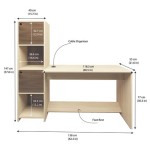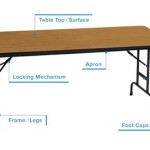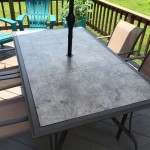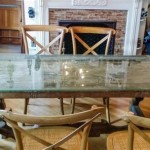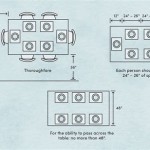Glass Lazy Susan: Enhancing Dining Table Functionality and Aesthetics
The glass lazy Susan, a rotating tray commonly placed at the center of a dining table, has evolved from a practical serving aid to a sophisticated design element. Its primary function remains facilitating easy access to various dishes for all diners, but modern designs incorporate aesthetics and durability, making it a desirable addition to many dining spaces.
The history of the lazy Susan is somewhat debated, with various origin stories attributed to different cultures and eras. Regardless of its precise beginnings, its purpose has consistently been to streamline the sharing of food and condiments, promoting a more communal and efficient dining experience. The use of glass in lazy Susan construction adds a layer of elegance and visual appeal that differentiates it from versions made of wood, metal, or plastic.
Glass lazy Susans are available in a wide range of sizes, shapes, and thicknesses, allowing consumers to select a product that complements their specific dining table dimensions and personal preferences. Common shapes include round, square, and rectangular, with diameters varying from small sizes suitable for condiments to larger sizes capable of accommodating multiple serving dishes. The thickness of the glass is a critical factor in determining its load-bearing capacity and resistance to breakage.
The manufacturing process of a glass lazy Susan involves several key steps. First, raw glass is cut to the desired shape and size. The edges are then typically ground and polished to create a smooth and safe surface. Some manufacturers employ tempering processes to increase the glass's strength and shatter resistance. Finally, the rotating mechanism, usually consisting of a bearing or rotating platform, is attached to the underside of the glass.
Key Benefits of Using a Glass Lazy Susan
One of the most significant advantages of a glass lazy Susan is its accessibility. By simply rotating the tray, diners can easily reach any dish placed upon it, eliminating the need to ask others to pass items or stretch across the table. This feature is particularly beneficial during large gatherings or family meals where multiple dishes are served. The rotating mechanism promotes equal access to food for all diners, contributing to a more equitable and convivial dining experience.
The transparent nature of glass is another attribute that makes it a popular material choice. Unlike opaque materials, glass allows diners to see all the items on the tray regardless of their position. This visual accessibility simplifies the selection process and reduces the likelihood of accidentally spilling food. It also allows the color and presentation of the dishes to be showcased, enhancing the overall dining aesthetic.
Aesthetic appeal is also a major factor in the selection of a glass lazy Susan. The clean lines and reflective properties of glass contribute to a sense of sophistication and elegance. A glass lazy Susan can complement a variety of dining table styles, from modern and minimalist to traditional and ornate. The versatility of glass also allows for various design options, including colored glass, frosted glass, and etched glass, providing further customization possibilities.
Factors to Consider When Choosing a Glass Lazy Susan
The size of the dining table is a crucial consideration when selecting a glass lazy Susan. The size of the lazy Susan should be proportionate to the table, allowing ample space for diners to comfortably reach around it. A lazy Susan that is too large can obstruct the dining experience, while one that is too small may not provide sufficient capacity for serving dishes. It is recommended to measure the table diameter and consider the number of diners typically accommodated before making a purchase. Ideally, the lazy Susan should cover roughly one-half to two-thirds of the table's diameter.
The weight capacity of the glass lazy Susan is another essential factor to consider. Overloading the tray can damage the rotating mechanism or even cause the glass to crack or break. Manufacturers typically specify the maximum weight capacity, and it is important to adhere to these guidelines. When planning the layout of the dishes, distribute the heavier items evenly across the tray to avoid placing undue stress on any single point.
The quality of the rotating mechanism is a critical indicator of the lazy Susan's durability and performance. A well-engineered rotating mechanism will provide smooth and silent rotation, ensuring that the tray spins effortlessly. Look for models with ball bearings or similar features that are designed for long-lasting performance. The material of the rotating mechanism is also important; stainless steel or other corrosion-resistant materials are preferable for resisting wear and tear.
Maintenance and Care of a Glass Lazy Susan
Proper cleaning and maintenance are essential for preserving the appearance and functionality of a glass lazy Susan. Regular cleaning will prevent the build-up of food residue and stains, maintaining its clarity and shine. Minor spills and smudges can be easily removed with a damp cloth and a mild detergent. Avoid using abrasive cleaners or scouring pads, as these can scratch the glass surface.
For more stubborn stains or dried food, allowing the area to soak in warm, soapy water before wiping can be helpful. It's also advisable to periodically remove the lazy Susan from the table and clean both the glass surface and the rotating mechanism separately. This allows for a more thorough cleaning and helps to prevent the accumulation of dirt and grime in hard-to-reach areas.
When handling the glass lazy Susan, it is important to lift it carefully to avoid dropping or bumping it against other objects. While tempered glass is more durable than regular glass, it is still susceptible to breakage if subjected to excessive force. Always support the tray from underneath when lifting it and avoid placing heavy objects on its surface when it is not in use.
Protecting the glass lazy Susan from extreme temperatures is also necessary. Sudden temperature changes can cause the glass to crack or shatter. Avoid placing hot dishes directly on the tray immediately after removing them from the oven or stovetop. It is recommended to use trivets or placemats to insulate the glass from direct heat. Similarly, avoid exposing the tray to freezing temperatures, as this can also compromise its integrity.
The glass lazy Susan, therefore, remains a functional and aesthetic addition to the dining table, streamlining meal service while contributing to the overall ambience. Careful selection and maintenance are key to ensuring its lasting benefit.

Steve Silver Avenue 40 Inch Glass Lazy Susan Com

Creative T9055 Lazy Susan Glass Dining Table

Modern Glass Top Dining Table With Center Built In Lazy Susan Leather And Chrome Base Four 4 Stitched Chairs

Indoor Outdoor Mocha Glass Lazy Susan For Dining Table 800mm Diamete Quatropi

Large White Gloss Dining Table Glass Lazy Susan Led Lighting 1 60cm With Chairs For

Large Round Dark Elm Dining Table Black Glass Lazy Susan Led Lighting Quatropi

Lazy Susan For Dining Table 6 Seater Set Round Tempered Glass Turntable Bearing Rotating Plate Desktop With Base Lazada Ph

Tempered Glass Lazy Susan Furniture Home Living Tables Sets On Carou

Royal Botania Ozone White Glass Dining Table Home Infatuation

Tempered Turntable Glass Dining Table Minimalist Round Top With Rotating Base Hotel Lazada Ph
Related Posts

